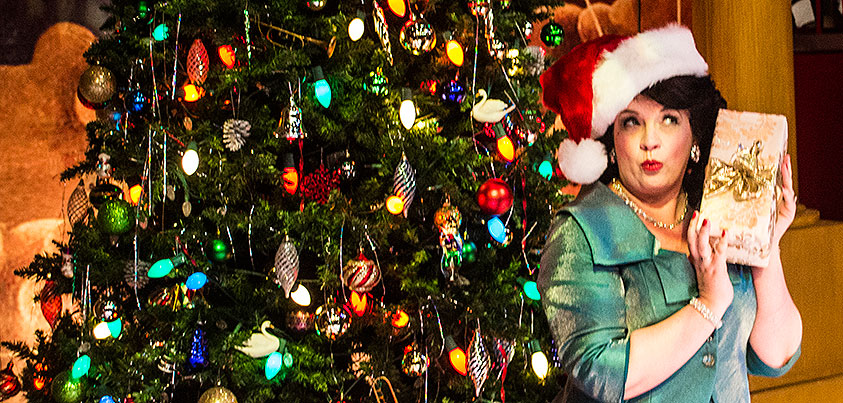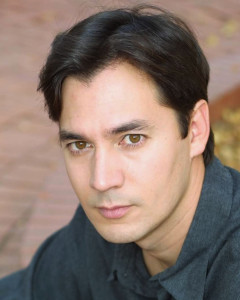The Difference is in the Details
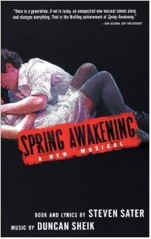 As you may already know, Duncan Sheik and Steven Sater’s Spring Awakening is a musical adaptation of the stage play written by German playwright Frank Wedekind in 1891. Even though most of the dialogue was pulled directly from the original script, it still took almost eight years, from its initial conception in 1999 to its Broadway premier in 2006, to get the musical version to where it is today. And there are some key differences that go beyond the mere addition of songs to the originally straight dramatic text:
As you may already know, Duncan Sheik and Steven Sater’s Spring Awakening is a musical adaptation of the stage play written by German playwright Frank Wedekind in 1891. Even though most of the dialogue was pulled directly from the original script, it still took almost eight years, from its initial conception in 1999 to its Broadway premier in 2006, to get the musical version to where it is today. And there are some key differences that go beyond the mere addition of songs to the originally straight dramatic text:
In the musical, the opening song “Mama Who Bore Me” is derived from a monologue Wendla delivers in Act 2 of the original text.
The entire scene during which Wendla questions her mother about the true nature of how children come to be doesn’t occur until about halfway through the original play.
 There are many more distinct adult characters in the original text.
There are many more distinct adult characters in the original text.
The musical cut multiple adult characters, and also designated that all adult roles were to be played by one male and one female actor.
There is no mention of sexual abuse in the original text.
Sexual abuse was something not talked about at the time it was written, and the vast majority of Spring Awakening was inspired by Wedekind’s own experience or those of his close friends.
The sex between Wendla and Melchior is non-consensual in the original text.
In Wedekind’s original play, Melchior rapes Wendla. The musical version turns this into a consensual act, giving Wendla more control and making Melchior more sympathetic.
After Moritz’ suicide in the musical, his father is depicted falling down in grief at the end of “Left Behind”, whereas he rejects him saying “The boy was nothing to me,” in the original text.
The concept of parenting is vastly different today, and this seems to be a change acknowledging that fact. While the play is set in the 1890s, the audience still lives in the early 21st century making it extremely difficult for contemporary audiences, particularly parents, to reconcile this shunning of a son after having lost him.
In the musical Wendla is taken to an abortionist by her mother in addition to the “French remedy” (code for abortion pill) she is prescribed in the original text.
This addition of seeing Wendla taken to an abortionist is done largely in the spirit of “showing instead of telling,” and provides more closure to her story.
The musical cuts out the part of the Masked Man who convinces Melchior not to kill himself in the original text.
By giving Melchior himself the power to stop himself, the musical version gives adolescents today the message that they have the power to take control of their own lives.
Moritz comes back and tries to convince Melchior to kill himself at the end of the original text. However the musical is much clearer about making Melchior the protagonist throughout, so this change in Mortiz’ attitude helps clear Melchior’s conscious of having played a role in his friend’s suicide.
Wendla does not appear again after she dies in the original text.
But much like the Moritz’ appearance in the musical version, Wendla’s presence offers closure for Melchior, absolving him of any residual guilt he has placed on himself for her death.
Happiness, Defined.
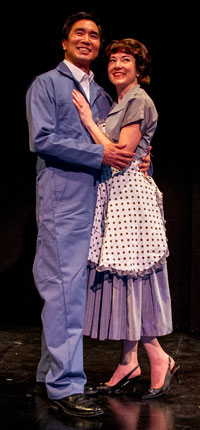
One of the joys of being a dramaturg is the simple task of discussing the core of whatever script you happen to be working on with anyone and everyone who is willing to engage you in conversation. A few weeks ago I had the privilege of talking with our teaching artist for Maple and Vine, Tim West, while he presented his lesson plans to me as part of our Engaging the Stage workshop series. As a fellow passionate history buff and seasoned theatre artist, he and I delighted in geeking out over the many social issues threaded throughout the script.
In many ways, Maple and Vine is a dramaturg’s dream. It is rich in historical content, touching on everything from the most popular car model in 1955 to gender roles and social attitudes towards various minority groups. I got to look up the most popular ring tone in 2011, what Sanka was (or is, given that it is still currently sold in stores), and when spray paint was invented. I had to research the history of the LGBT rights movement and post-WWII attitudes towards Japanese-Americans. I learned that the year Rosa Parks refused to give her seat up to a white passenger on a bus in Montgomery, Alabama was the same year the McDonalds Corporation was founded, two dogs slurped a spaghetti noodle and ended up smooching, and the happiest place on earth opened for business.
Now as much as I enjoyed this work, deep down I knew… that’s not what this play is about. Not REALLY. It’s all essential information for making sense of the world in which this story takes place, sure. And one of the key functions of a dramaturg is ensuring the accuracy and dependability of the world in which the characters exist. But is the play about glamorizing the role of the 1950’s housewife over the 21st century powerhouse corporate woman? Is it about the wrongful treatment of Japanese-Americans during and after WWII, or the struggles of being a homosexual man during a time when loving someone of the same sex was widely considered a psychological disease? No. At least not in my opinion.
What is happiness and how do you define it? What would you sacrifice for happiness? What does it mean to live life authentically? These are the questions at the heart of Jordan Harrison’s thought-provoking play. Maple and Vine strategically presents the downfalls of 21st century living right alongside the positives of life in 1955, forcing us to question whether or not we really are happier in this age of progressiveness and convenience. And as our director, Igor Goldin, states in his program notes, “Everyone will have their own opinion which will be informed by their own histories, but with every answer will come a contradiction… As in life, nothing is black and white. Life is messy and untidy. There are no easy answers, nor does Mr. Harrison try to create any. He just presents the hypothetical and leaves the rest for us to debate.”
So won’t you join us on Sunday, February 9th after the 7:00pm performance of Maple and Vine for what is sure to be an engaging talkback on the matter of happiness? We are pleased to welcome back Dr. Edith Frampton, professor of English and Comparative Literature at San Diego State University. Joining her in leading the talk will be SDSU colleague Dr. Peter Herman. You can purchase tickets here. See you there!
Bringing back the 50s with director Igor Goldin
Thanks to the miracles of modern technology, last month we were able to Skype with Maple and Vine director Igor Goldin from his New York apartment where he was working on a new musical. He provided some very interesting insights about the process of bringing the new comedy to the Cygnet Theatre stage. Maple and Vine by Jordan Harrison, runs January 16 through February 16.
CT: This is your first time directing at Cygnet Theatre. How did you get connected?

I was in San Diego directing for Diversionary Theatre and had a chance to see several productions and fell in love with Cygnet. I saw Cabaret and It’s a Wonderful Life: A Live Radio Play and loved the creativity and specificity in which they were performed and directed. I also had seen a Caryl Churchill play produced years ago at the Rolando Stage, A Number, and was extremely impressed with the texture and gray areas in the piece and how it didn’t spoon feed the audience, but trusted them to come up with their own answers. Sean [Murray] and I went to North Carolina School of the Arts together. He saw my production of Yank! and thought of me when they put Maple and Vine on the season. We had both wanted to work with each other for some time so I’m thrilled that it worked out with Maple and Vine.
CT: Maple and Vine is about a modern day couple who choose to leave the big city and move to a gated community where the residents live like it’s 1955. How will you present these opposing settings?
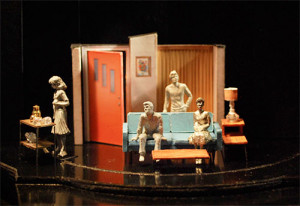
I’ve been skyping with set director Sean Fanning and we are both excited about the addition of a turntable to the Cygnet stage. The structure of the play is very episodic with short scenes involving quick scenic, costume and lighting changes. The turntable provides an opportunity to shift eras and locations quickly and keep the show fluid. It’s a dark comedy that deals with important social issues and I’m certain audiences will debate them after the show, but during the performance, it’s important to keep things moving, with each scene flowing seamlessly into the next.
CT: What about the look and feel? How are you working with designers to create both eras?
We are limited by the resources and economy of a nonprofit theater, but that is a challenge I rather enjoy. I’d much rather solve problems creatively within constraints than have a bloated budget and throw everything at the audience. We’ll be working with simple iconic set pieces that are clearly grounded in the era they represent. In fact, the concept of limited resources is one that resonates within the play because going back to the 50s means we don’t have everything at our fingertips as we do today
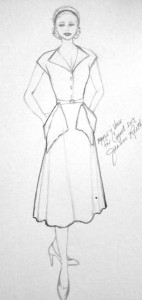
I’m also working with costume designer Jeanne Reith to capture the quality and specificity of each era. The 1950’s Ozzie and Harriet/Leave it to Beaver look has a warm and cozy feel, while the urban sleek style of today’s New York has a totally different feel. We’ll also be working with a variety of rigging solutions for quick changes. The lighting and scenery will define the 2 eras with a sleek, angular, urban starkness for 2011 to a saturated, warmer and softer look for 1955.
CT: The comedy looks at attitudes about gender, race and sexuality. What is it “really” about for you?
It’s a light but penetrating comedy that explores what happens when we are stripped of the liberties of this world and forced to live within the narrow social structure of 1955. In the 50s there is a veneer of contentment that cloaks what’s lurking underneath. It’s about what we are hoping to reclaim within ourselves by living in a world with less freedom and equality, what we are willing to walk away from and what we lose and gain through the process. It about what it means to live your life authentically.
CT: What would you miss most if you had to return to the 1950?
My freedom as a gay man.
CT: What would you miss the least?
The constant bombardment of information and the false sense of connectivity and accessibility that we get with our hand held devices and social media.
New Jammies
Another Holiday Memory for you today, this time from Resident Artist Melinda Gilb. You may remember Melinda from Dirty Blonde, Assassins, or The Receptionist.

“I have many memories of Christmas growing up. One thing that we always got was new pajamas. I think many people have that tradition in their family. Maybe it’s an American thing, not sure but I always give my child new jammies for Christmas and fruit, nuts, candy and money in the stocking. I loved ribbon candy.” – Melinda Gilb
Fire Department Santa
Our next Holiday Memory comes from Resident Artist Melissa Fernandes. Along with appearing in 7 of the last 8 Holiday Radio Plays, Melissa has appeared in Company, Assassins, Little Shop of Horrors, A Little Night Music and The Book of Liz.
“One of my favorite memories from my childhood was having Santa actually visit our house on Christmas Eve. I lived in a fairly small community and (as I found out when I was older) the local fire department would have volunteers dress up as Santa and visit homes to give the kids living there a present. My grandmother would secretly set out a couple of presents by the front door (again- small town, one could get away with that back then) and then Santa would knock on the door and bring them in to me. The Santa costume was always tattered and the beard was awful, but I will always remember how happy and excited I was to see Santa every Christmas eve.” – Melissa Fernandes
My First Tangerine
We asked cast members of A Christmas Carol: A Live Radio Play to share some of their favorite holiday memories with us. This first one comes from our “radio host,” Jonathan Dunn-Rankin, who is appearing as Freddie Filmore in our annual Holiday Radio Play for the 7th consecutive season. Enjoy.
“When I was six year old and my brothers were seven and nine we were staying with our paternal grandparents on Long Island while our mother and father were establishing a new life for us in Florida. It was 1936 and the Great Depression was still in full swing. On Christmas morning we three boys found at the bottom of our Christmas stocking hung on the mantel what seemed to our eyes a gigantic tangerine. It was so sweet, so succulent, so easily peeled, so enchanting. For more than 75 years I have been trying to approximate that singular experience of my first tangerine. And clementines come pretty darn close! A few days later our grandmother took us into Manhattan and put us on a train for Miami and we celebrated New Year’s Day in our new home.”
– Jonathan Dunn-Rankin
What the Dickens?
 This holiday season, Cygnet Theatre is excited to bring back our live radio version of A Christmas Carol. We’ve been doing a bit of research on famed British writer Charles Dickens, author of Oliver Twist, Great Expectations, David Copperfield, The Life and Adventures of Nicholas Nickleby, A Tale of Two Cities and of course, A Christmas Carol and what we found was pretty interesting.
This holiday season, Cygnet Theatre is excited to bring back our live radio version of A Christmas Carol. We’ve been doing a bit of research on famed British writer Charles Dickens, author of Oliver Twist, Great Expectations, David Copperfield, The Life and Adventures of Nicholas Nickleby, A Tale of Two Cities and of course, A Christmas Carol and what we found was pretty interesting.
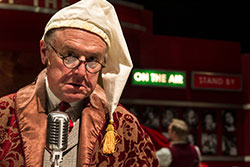
Photo by Daren Scott.
Despite being one of the very first-ever literary superstars, most people don’t know many details of his life. For example, you may be aware that Dickens grew up poor, but did you know that he was mostly self taught? After his father was jailed for having “bad debts,” Dickens was forced to leave school and start work in a blacking factory (a boot polish factory). What about the fact that he knew shorthand? Indeed, his first business card, which he got made at some point between 17 & 19, had his occupation listed as “Short Hand Writer.”
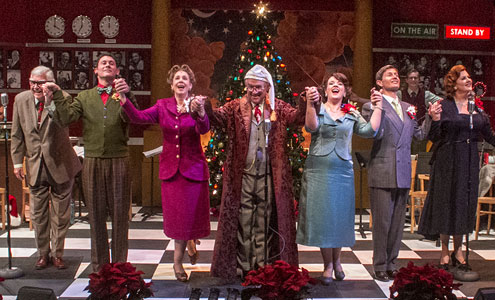
Photo by Daren Scott
Dickens also suffered, at least in childhood, from epilepsy. Having described three of his characters as having epileptic seizures, or ‘The Falling Sickness’ (Edward Leeford in Oliver Twist, a headmaster in Our Mutual Friend, and Guster in Bleak House), modern doctors find his descriptions of the disease remarkably accurate for a period when little was known about it. He probably had OCD as well, and reportedly had a habit of rearranging furniture whenever he stayed in a hotel room having to sleep with his head pointing north, and would inspect his children’s bedrooms every morning, leaving behind notes when he was not satisfied with their tidiness. And those notes were more often than not addressed to “Chickenstalker,” “Skittles,” “Plorn,” or one of the other many nicknames he had for each of his 10 children.
To learn more about this intriguing author, join us on December 8th after the 7:00pm performance of A Christmas Carol: A Live Radio Play for a talkback with Dickensian expert Dr. Edith Frampton, professor of Comparative Literature at San Diego State University. Hope to see you there!
More Split Personalities with Maggie Carney
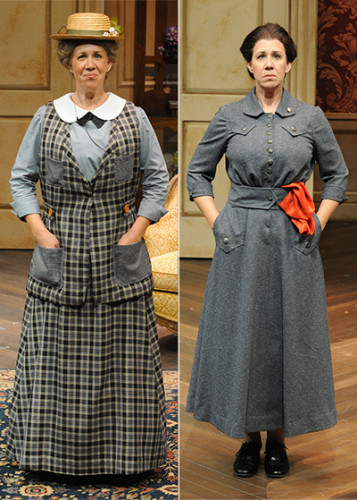
This week we sit down with another actor to talk about her roles in The Importance of Being Earnest and Travesties.
Who are you playing in both shows? What are their similarities, and what are their differences?
I play Miss Prism in Earnest. Prism is Cecily’s governess and companion… she also harbors a deep dark secret. In Travesties I play Nadya, a Russian revolutionary and the wife of Lenin. Nadya came from an upper-class but impoverished home, Prism is middle working class. Nadya and Prism are approximately the same age. Prism has a streak of Socialism and an interest in “causes” compared to the committed Marxism of Nadya, though they are both very passionate about their beliefs on all subjects. They are approximately the same age. Nadya is taller and slimmer than Prism and less fussy. Prism has accessories and tchotchkes that Nadya would never have. And finally, Nadya speaks with a slight Russian accent and Prism is British through and through. These are just some of the similarities and differences.
What is the funnest part(s) of playing multiply characters in Rep?
I love playing multiple characters in any situation, and in rep it’s even more fun. I get to play with the same creative team in 2 different plays! We know each other very well, after rehearsing since the end of July. The real challenge will be remembering what show I’m doing on a given night. I’ve done rep before and there’s nothing like getting dressed for Lady Percy in Henry 4, Part One and realizing at 15 minutes to the top of show I should be in Calphurnia for Julius Caesar! I’ve never gotten undressed and dressed faster in my life.
What are some of the challenges you are facing?
As a supporting actor in both shows, my greatest challenge is to keep my energy level up for my entrances. I must be fully present when I hit the stage to meet the energy level of my scene partners and increase the level with my presence and new information. I fill my down time backstage with crossword puzzles, crocheting and chatting with the other actors who are offstage. And Facebook, too!
If you are able to see both shows, I would highly recommend seeing Earnest first…there are so many echoes in Travesties it is fun to find them after seeing Earnest. Of course, these are stand-alone plays, so however it fits with your schedule, come and see us!
Split Personalities with Jordan Miller
Cygnet’s current production is not one, but two plays, The Importance of Being Earnest by Oscar Wilde and Travesties by Tom Stoppard, performed in rep by the same company of actors. We sat down with Jordan Miller to learn a little about performing in these two classic comedies.
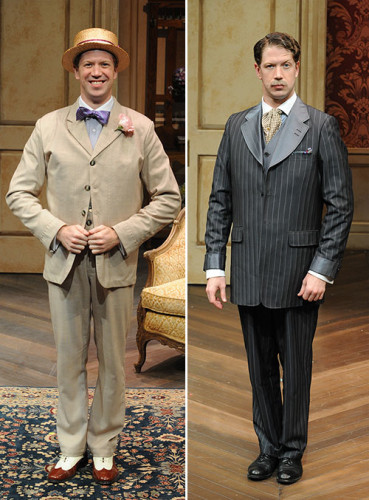
Who are you playing in both shows? What are their similarities, and what are their differences?
I’m playing “Algernon” in The Importance of Being Earnest, and “Henry Carr” in Travesties. The character of “Henry Carr” is inspired from the real life Henry Carr who fought in WWI and who played “Algernon” in a production of Earnest that was produced by James Joyce. The duality of the role in the play is taken from this real-life experience and forms the basis for the nods to The Importance of Being Earnest by Tom Stoppard. Both characters exemplify the “dandy” and boast very elevated and witty language, but “Algernon” is everything “Carr” wishes he was! While “Algernon” is always debonair and relaxed, “Carr” is self important and haughty, “Algernon” always wins in the end, and “Carr” is always left holding the bag. “Algernon’s” opinions and platitudes are always lighthearted but true, and “Carr’s” are always deeply passionate but often one-sided and flawed.
What is the funnest part(s) of playing multiply characters in Rep?
I don’t know if “funny” is how I would describe it but something that has been a delightful frustration for everyone is when the dialogue from one show creeps into the other, especially when the lines are so similar! And what is a great reveal in one show is played upon in the other, often with the substitution of a single word, and when in the moment you forget which show and line it is, it can make for some panic moments inside your head and for your scene partners!
What are some of the challenges you are facing?
With “Algernon” the biggest challenge (as Sean warned!) is constantly eating all the cucumber sandwiches and muffins and still speaking your lines eloquently! The text of both plays is a huge part of what makes them so wonderful; however, the language in both, once it finally gets into your memory, has a tendency to run away with you because it is so musically structured, and while it may be fun for the actor to rip through the dialogue it can become far too fast and clipped to be comfortably followed. With “Henry Carr,” he is more demanding because in addition to his substantial and complex “Old Carr” stream of consciousness memory monologues (Stoppard’s nod to “Ulysses”), he has several heated and impassioned scenes which can, like the dialogue, engulf you in the emotion and suddenly the scene becomes too heated and real and loses its comedic elements. Both characters are delightful to play, and tackling both at once has been an artistically rewarding challenge!
Are their any Rules of Etiquette from the era of Earnest that you wish were still around today?
I think basic rules of etiquette and manners are things which could stand to be reinforced today! Oh, and modern fashion could take some lessons as well.
Behind the Scenes with George Yé
Katie Harroff sat down with director George Yé to talk about the his experience working on Shakespeare’s R&J.
What is your history with Cygnet Theatre?
I’ve been working with Cygnet ever since 2004, I think, way back when Sean and Bill opened the space in Rolando. I designed sound for a number of shows, directed a production of Copenhagen in 2006, and other staged readings. In 2005, I produced and directed an independent project in the Cygnet Theatre space called . . .and then he met a woodcutter. Around that time I was asked to join Cygnet as an Associate Artistic Director. It was an honor I could not pass up. I continued to design, and work on various productions, and helped develop the sound system for the Old Town Theatre. Some years back we produced Escanaba in da Moonlight; for which I won a Craig Noel Award for sound design. I’m deeply committed to the continued growth and development of the company and humbled and overjoyed to participate artistically as well on R&J.
What drew you to R&J?
I love working on Shakespeare. Though I don’t get to do it very often, I actually have some intensive training. Working on this production afforded me the chance get my feet wet with some classic text while at the same time working in a contemporary way. It tells a coming-of-age story fueled with teenage angst, hormones, sensations of first love, and lust. It’s gritty. I like how Calarco’s interpretation of the original text and the students’ story align perfectly and call on the audience to experience the play through a new optic making it seem quite fresh. I was attracted to the potential the play has to challenge and reveal assumptions people have about gender, identity, and also how we can and should interpret and stage classic texts in 2013. I also was very excited to work with some of the great designers who usually work with Cygnet.
What was the hardest part about staging this piece?
The end. The actors and myself deliberated on the ending a number of times. I suspect years from now, I’ll be sitting in a café with a friend and will yell out of nowhere, “Ah! That’s it! That’s what we should have done for the ending!” I waited till very late to set the ending of the play. I knew it was a sacred moment for the cast, and I didn’t want to shut down the creative process too early, yet at the same time, everyone was looking for the right way to end the play. I had to wait and see a few run-throughs with the cast fully committed to each moment before I could start to feel comfortable with a plausible ending.
Why should people come see this show?
It celebrates the medium of theatre on so many levels. The play calls on the audience to use their imagination. Peter Herman the costume designer found us a sturdy bolt of red silk that weaves it’s way through all the action of the play. This elegant prop transforms into many items that help tell the story; vial of poison, rapiers for fight scenes; a knife, a turban, and many more. It really has turned out to be the fifth performer on stage. It’s miraculous to see how the actors use it. It’s a great play for the thrust space in the Old Town Theatre, and it addresses contemporary issues of censorship, oppression of youth, filial love and friendship, the power of first love. It’s something not to be missed.
